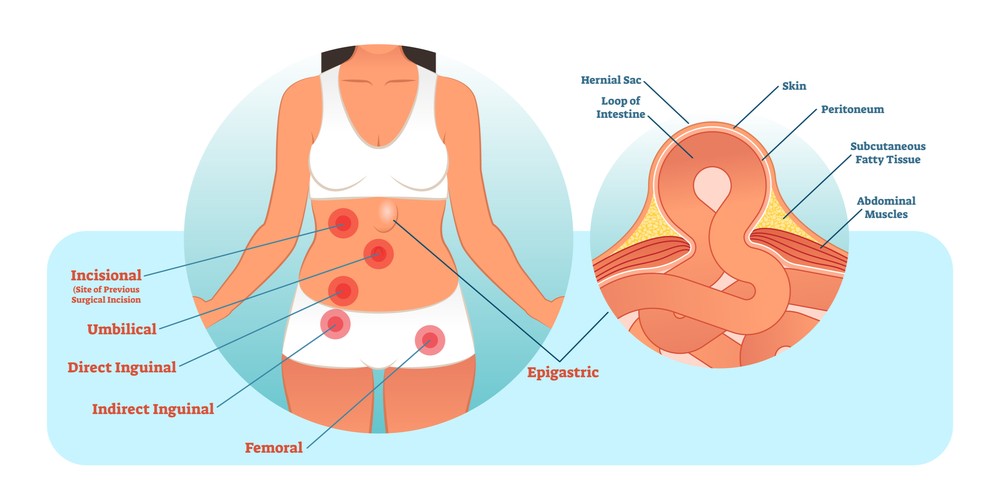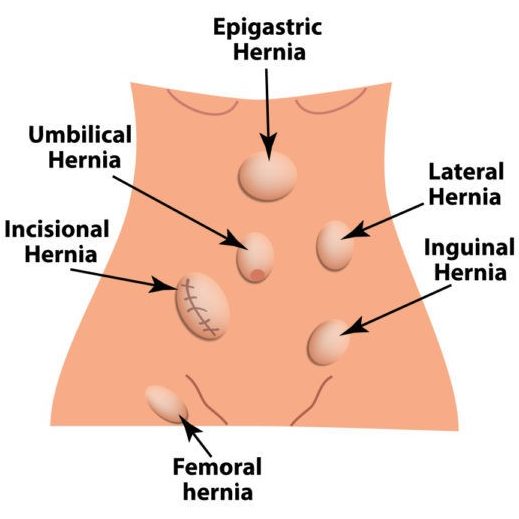
A hernia can be a devastating situation for a person who is suffering from it. Generally, a patient may feel pain in the area where the hernia is developed. But many people may remain asymptomatic for a longer period of time and develops symptoms when it becomes a major problem.
A hernia often shows up when you have that weak spot in your muscle or fascia, which causes the organs or the fatty tissues to apply pressure onto that weak spot leading to a bulge or a fluid-containing sac called a hernia.
There are various types of hernia that develop as a result of weakened muscle or fascia. It may be congenital or acquired. Risk factors for a hernia include constipation, cystic fibrosis, tobacco use, alcohol abuse, severe coughing, lifting heavy weights, and may even develop as a result of post-surgery.

Table of Contents
Where is Hernia located in the body?
Types of hernia and their location
There are several types of hernia. The classification of hernia is on the basis of the area of their occurrence into the inguinal hernia, umbilical hernia, femoral hernia, incisional hernia, and hiatal hernia.
Inguinal hernia:
Inguinal hernias have the most common recurrence rate when compared to all other hernias. Men usually tend to suffer from inguinal hernia because the muscles in their groin are weak
Where is the inguinal hernia located?
The inguinal canal is the area in male individuals where the spermatic cord passes from the abdomen to the area of the scrotum. It is located in the groin area of men. Inguinal hernia results when the intestines push through a very weak spot in the lower wall of the abdomen, often in the inguinal canal. In females, the inguinal canal constitutes a ligament that helps in holding the uterus in its place.
Hiatal hernia:
A hiatal hernia occurs when the stomach part protrudes in an upward direction through the diaphragm into the cavity of the chest. This type of hernia is very common in people above 50 years. In some rare cases, a child may suffer from the same condition due to congenital birth defects.
Where is hiatal hernia located?
It occurs in the weak muscle or diaphragm that consists of a sheet of muscles. The diaphragm acts as a boundary between the alimentary canal and the pulmonary system. Hiatal hernias are associated with GERD, where the contents of the stomach leak backward into the esophagus, causing heartburn.
Umbilical hernia:
Most of the children/infants suffer from Umbilical hernias. Umbilical hernia results due to weak muscles found in the area of the belly button. Adults can also suffer from this problem like ladies with multiple pregnancies, fluid present in the abdomen, and obese people.
Where is the umbilical hernia located?
This basically happens when the intestinal contents bulge through the wall of the abdomen near the navel.
Incisional hernia:
It is a type of abdominal hernia that results due to incompletely healed wounds after surgery. It is a type of ventral hernia, which is formed at the site of a healing surgical scar. Incisional hernias account for about 15-20 % of all abdominal hernias.
Where is the incisional hernia located?
It is located at the front of the abdomen at the site of previous surgery
Femoral hernia:
Femoral hernias affect women, most commonly older age women. This is because of the wider shape of the female pelvis. Femoral hernias are rare in children and males.
Where is the femoral hernia located?
It is located in the femoral canal of females, in the groin area at the top of the inner thigh.

What are the symptoms of a hernia?
Hernias are broadly classified into two types- external hernias and internal hernias. External ones are easier to identify as the bulge is located outside the muscular wall, and the internal hernias are the ones that push inside the abdominal wall into the organs. Some of the common symptoms of a hernia include:
- A lump or bulge in the abdomen or umbilical, and groin area
- Pain and burning sensation in the affected area
- Constipation/obstruction of the bowel
- Tenderness in the abdominal area.
- Nausea and vomiting
- Abdominal distension/ swelling
Diagnosis of Hernia
Diagnosis of a hernia is very complex because sometimes the hernias that are located in the deeper tissues remain unidentified. Delay in diagnosis and treatment risks the life of a patient.
Common diagnostic tests for hernia are as follows:
- Visual examination- A physician will first do a quick check by examining the person who had a complaint of a bulge in the abdominal or groin area. During this examination, the doctor examines the formation of a bulge which increases when the person works or due to continual standing, and coughing, or straining too. Then, the doctor will look after your medical history. Sometimes, when the doctor is unable to understand where the hernia is located and can’t examine the bulge physically then, the doctor will ask the patient to undergo imaging tests that can aid in their diagnosis. Some of the imaging tests include:
- CT scan – A powerful X-ray radiation is transferred to the site of the hernia which produces an image of the hernia by producing an image on the computer.
- Abdominal Ultrasound – In this technology high-frequency sound waves are passed that creates an image of the structures inside the body through which it becomes easy to diagnose the location of the hernia
- MRI scan – In this scan, a combination of strong magnets and the radio waves are passed on the abdominal or groin area to produce an image
Above all, if an individual is suffering from a hiatal hernia, then your physician may use various other tests which allow them to determine the internal position of your stomach like Endoscopy and Gastrografin or barium X-ray
How to prevent a hernia?
One may ensure considering various factors in order to prevent a hernia. Some of them include:
- Ensure strong muscles in the abdominal and groin area by doing some physical exercises.
- Massages after birth ensure uniform blood circulation throughout the body and thus prevent hernia in children to a great extent.
- Reducing weight by eating sensibly and fulfilling the daily nutrients
- Avoiding indulging in heavy weight lifting to prevent hernia recurrence after the surgery
Though the following things are effective. You may still get a hernia. And, so far, you must have learned that undergoing surgery is the right thing to do to keep away from any complications.
Final Words
A hernia is one of the diseases that many people suffer from, but only a few people may notice and have an idea of what it is. It can become a life-threatening disorder if not addressed on time. Many people may think that it’s just a mass of fatty tissue while others get terrified that it’s a sign of cancer. Although hernia initially does not show any symptoms, pain and a small may be the initial symptoms to catch your attention
Also Read:







